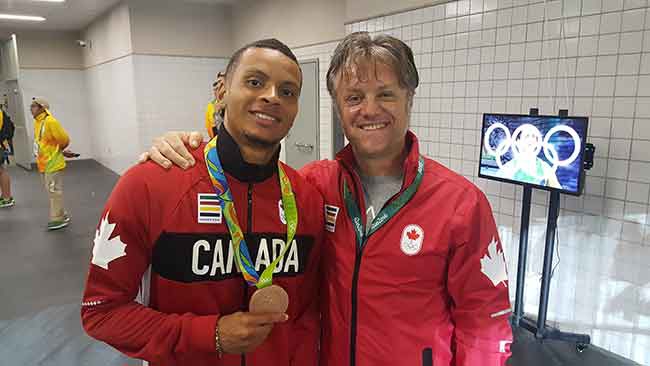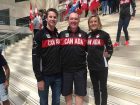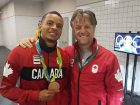
Olympic team
By Beatrice Paez and Mari-len De guzman
NewsSupporting the health of Canada’s greatest athletes
 Dr. Alban Merepeza (right) with Andre De Grasse at the Rio 2016 Olympic Games Photo credit: Dr. Alban Merepeza
Dr. Alban Merepeza (right) with Andre De Grasse at the Rio 2016 Olympic Games Photo credit: Dr. Alban MerepezaAfter more than two weeks of gruelling sports action, the 2016 Summer Olympics in Rio concluded with Canada’s best athletes bringing home a total of 22 medals.
Behind the nation’s Olympians is the usual entourage of patriotic fans, dedicated coaches, supportive family and friends.
Not to be overlooked, however, is the medical support staff who stood attentively by the sidelines to ensure Canadian athletes were in optimal health for the competition. They include chiropractors, who have travelled alongside many athletes and have witnessed and been instrumental to their success – from superstar sprinter Andre De Grasse to world champion high jumper Derek Drouin, who both nabbed Olympic medals in the 2016 Olympic Games in Rio de Janeiro last summer.
Chiropractors Dr. Alban Merepeza, of Port Hope, Ont., and Dr. John Vargo, of Sarnia, Ont., filled two spots on Athletics Canada’s medical team travelling with the athletes to Rio.
Another chiropractor, Dr. Josh Binstock, who made his Olympic debut in London 2012, squared off once again with the world’s top beach volleyball players in Rio. At an unofficial capacity, the chiropractor from Richmond Hill, Ont., says he often provides care for his beach volleyball partner, Sam Schachter.
As athletes themselves, the three practitioners say they have experienced firsthand how chiropractic treatment could make a difference in an elite athlete’s performance.
Binstock says he’s in a unique position to understand and empathize with how athletes manage their pain. “A lot of my colleagues at school, they could learn from a book and write an exam, but they don’t know how much pressure to give, what structure to really push and what it feels like to have this discomfort,” he says.
High-stress events, such as world championships, also call for a slightly different approach.
“People are a little more anxious, so you have to tone them down, make them more relaxed,” says Vargo. “It adds a different element to the normal aches and pains.”
Growing up, Binstock found chiropractic treatment to be the most effective in helping him rebound from sports injuries. This exposure persuaded him to pursue a profession in chiropractic. “I knew how I felt after being treated,” he says. “I just wanted to help other people feel that way as well.”
Similarly, Vargo credits his own chiropractor, the late Dr. Gary Hare, for inspiring him to marry his love of sports and medicine. Throughout high school and university, Hare treated him for basketball- and football-related injuries.
“He took care of all my injuries,” says Vargo. “I couldn’t have been happier. He inspired me to do what he did.”
For Merepeza, it was a “natural progression” to transition from his soccer career to chiropractic care. Initially, he looked after local soccer teams, expanded to hockey and swimming, before graduating to the big leagues – recruited to serve at international competitions.
Hard work
Rio was Merepeza’s fifth round at the Olympics, starting with Beijing in 2008. Team Canada’s sprinters are his regulars. One of this year’s Olympic favourites, sprinter Andre De Grasse, has been a patient of Merepeza’s since the beginning of his athletics career. He witnessed De Grasse’s evolution from accidental sprinter to Canada’s fastest man, just strides behind the world’s fastest man Usain Bolt.
“I’m extremely happy for him, because I’ve seen him working hard all through his career,” Merepeza says of De Grasse, who took home the silver medal for the men’s 200-meter event, and bronze medals for men’s 100-meters and 4×100-meter relay. “Yes, he’s extremely talented, but he also works very hard and he’s very focused.”
Merepeza is proud to have contributed to the success of Canada’s athletics team, but stresses he is merely a spoke on the wheel of these athletes’ entire crew. He does, however, make sure he does his part really well for the athletes.
In De Grasse’s case, for instance, he says, “I just ensure that he’s healthy and he is biomechanically sound, and he performs well. That is my job.”
Having worked for other Olympic delegations, Merepeza was invited to apply to join Athletics Canada’s medical staff. His credentials, coupled with his experience working with Olympic hopefuls, clinched it for him.
In the four years leading up to the Games, the staff is brought on board so athletes have an opportunity to get to know them. They tag along at various competitions to see if they work well together.
“Athletics Canada has done a great job of building a team of coaches familiar to them,” says Vargo, “so they have this built-in comfort zone.”
It was Vargo’s sports fellowship and experience treating NHL players and Sarnia, Ont.’s hometown heroes – such as middle-distance runner Hilary Stellingwerff – which made him an asset.
“If you’ve been in the trenches with them for the last few years,” says Vargo, “they know who you are and are more likely to sit down and talk to you.”
One of the most unforgettable moments – and perhaps the proudest moment – for Vargo at the Rio Olympics was when Derek Drouin bagged the gold medal in men’s high jump. Drouin has been under Vargo’s chiropractic care since he was 11 years old.
Vargo recalls the moment Drouin made his Olympic gold-winning jump, watching from the sidelines with Drouin’s parents beside him. He didn’t care that he started to tear up as he realizes the young boy who first came into his chiropractic clinic for a hockey injury is now an Olympic gold medalist – and he’s been a part of that journey.
“People who saw me on TV sitting beside his parents were saying, ‘you look so proud.’ In somebody like (Brouin), if you watch him on TV, you knew how well he represents Canada in his demeanour, in his poise, in his character. How could you not be proud to be a part of his team?” Vargo says.
Road to Rio
Although this was not his first Olympic journey, Binstock still endured a lengthy process to score the second – and final spot – for men’s beach volleyball for Rio 2016. He earned his Olympic berth in a hard-fought showdown in July at North Bay, Ont.
Although he is fulfilling his passion for sports, Binstock also makes sure he continues to practice his profession, so dutifully split his time between training for Rio and treating patients. He carved out blocks of time for each activity: practices from 8 a.m. to 10 a.m., workouts from 12 p.m. to 2 p.m., and appointments from 3 p.m. to 8 p.m.
Binstock stuck to his regimented schedule for a while, but he suffered an abdominal tear, which made him realize he couldn’t do it all. “I had to stop working this past year because the rehab process itself was so time-consuming, in addition to the training.”
Apart from the prized opportunity to face off against the best of the best in beach volleyball, Binstock relishes moments when he gets to watch others perform at their peak.
“I just love connecting with different athletes from around the world,” says Binstock. “You appreciate each other’s sacrifices and understand their way of life.”
And for Merepeza and Vargo, the joy of witnessing athletes who they’ve long cared for perform on the world stage, is one that never loses its lustre. “The greatest thing for me is I’m following people I’ve been treating for the ultimate event,” says Merepeza.
Crunch time
The chiropractors know the treatments they provide at the Games are crucial to the athletes’ performance at game time. Both Vargo and Merepeza note treatments take a different route when it’s crunch time – as opposed to pre-game sessions.
“The change in frequency is definitely one major change between treating them in the office and treating them at a major event,” Merepeza explains. Athletes get chiropractic treatment before a competition and right after, assessing them and making sure they are ready for the next event.
Assessing the athletes – making sure they are moving well, that there are no restrictions anywhere, and that they are in great shape biomechanically – makes up most of the chiropractors’ job during major games.
During the Games, Merepeza’s treatment protocol changes as well: from an injury-prevention-based
approach to a performance-based approach.
“At that point, we know they’re healthy, we know they’re prepared to do their best, we just have to make sure that their body responds the way it should. That is the only way they can produce results. If they’re restricted somewhere, and somehow that goes unchecked, it definitely may affect their performance.”
The therapeutic and trust relationship between the athlete and their chiropractor – or other medical providers on the team, for that matter – also plays a role during game time, explains Vargo.
“(The athletes) know you personally and they know how you treat, so that when it’s crunch time, if something bad is happening there is a built-in comfort level,” Vargo explains. “There is so much pressure and publicity, and all of those psychological things like fear and doubt. So the more familiar things they are surrounded with, the better it makes them and the better it makes them able to cope with the stressors that high-level sport places upon them.”
The trust relationship between these chiropractors and the athletes they care for is built up over time. It becomes so strong that these athletes, no matter how far they go in their careers or in their lives, would always go back to that chiropractor they trust to make them feel better and perform better.
Vargo, for instance, has travelled with Drouin and his coach to some of his most important games.
Many in the Athletics Canada team travel to Merepeza’s clinic in Port Hope, Ont., to get treatment from the veteran chiropractor. De Grasse, who is now a senior at the University of Southern California in Los Angeles, regularly travels back to Port Hope to see Merepeza. The chiropractor has also flown out west a few times to see and treat De Grasse.
When De Grasse suffered a toe injury earlier this year, some three months prior to the Rio Olympics, he flew back to Toronto and stayed in Port Hope for a week under Merepeza’s care.
“It was a biomechanical issue that we had to deal with. So he came home and he came to Port Hope for a week, with the permission of his coaches, and we all agreed that was the best thing. I worked with him and he was able to leave and go back to Phoenix (Arizona) symptom-free. We gave him a set of exercises to do and some instructions for his chiropractor and massage therapist in Phoenix, which they followed really well. The results were fantastic,” Merepeza says.
From the trenches
The opportunity to work at one of the biggest international sporting event and contribute to the success of the athletes is a testament to chiropractic’s increasing role in the world of sports.
“It’s a really exciting time in the world of chiropractic,” Vargo says. “The athletes drive the machine – we don’t decide how many treatments are required. Their utilization of our services is what helps drive the machine.”
Being part of the medical team supporting national athletes also provided valuable and eye-opening experience for the chiropractors, working alongside some of the country’s best sports clinicians.
Vargo says it is “humbling” to be part of the medical team. Everybody works together, putting their skills into one “melting pot” and “checking their egos at the door” for the betterment of the athletes.
“It’s nice to see that system actually works,” Vargo says about interprofessional care. “It’s something that we all sit around and theorize about and hope we could do it someday. And the Olympics is an environment where it actually works.”
Merepeza and Vargo are only among a big population of chiropractors who are making their mark in the sports world in different teams and in different levels. Many more will come after them, but not without hard work, sound clinical skills and lots of patience.
For the young chiropractors who are thinking about making it to the Olympics some day, Merepeza offers some advice. “You really need to be a great clinician – not a good clinician, because the majority of clinicians are good. The only way you’re going to be a great clinician is by gaining experience. So the sooner you get out in the field and start putting in your time and honing your skills, the sooner you’re going to get to this level.”
He notes working with a team does not guarantee a spot at the next big game. Practitioners have to prove they are worthy to be on that team by producing very good results, and showing the team they are the right chiropractor for the job.
Patience and hard work will come a long way to get to where you want to be, adds Vargo.
“Don’t expect too much too soon. You need to start working with younger athletes and grow with them. You need to understand your skill package, then get really comfortable with the skills that you’re taught in school, and continue to grow as a practitioner. One day, as (the athletes) grow through the ranks so do you and you’ll look up and you’ll find that some of those young athletes you started working with are, all of a sudden, world champions and Olympic champions, and they’ve pulled you along with them and motivated you to become a better practitioner, just like they’re motivated to become better athletes,” Vargo says.
Beatrice Paez is a freelance writer based in Toronto. You can contact her at beatrice.paez@gmail.com.
Mari-Len De Guzman is the editor of Canadian Chiropractor magazine. She has been a journalist for 20 years and has been editor of several business and professional publications. You may contact her at mdeguzman@annexweb.com
Print this page

